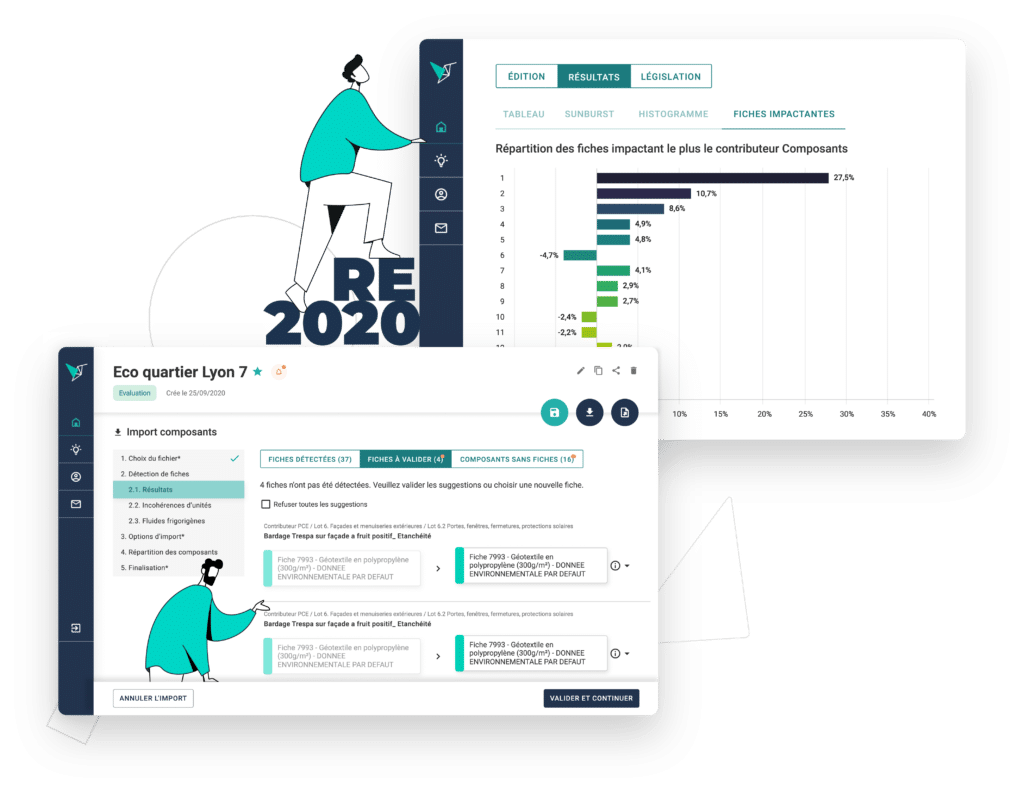Qu’est-ce qu’une FDES ?
Une Fiche de Données Environnementales et Sanitaires (FDES) est la source de données environnementales sur les produits de construction reconnue en France pour réaliser une Analyse de Cycle de Vie (ACV) d’un bâtiment.
Elle décrit le profil environnemental d’un produit de construction d’après son ACV qui quantifie ses différents impacts environnementaux. Ainsi, elle reprend toutes les étapes du cycle de vie de la menuiserie réparties en groupes de modules d’information.

A quoi sert une FDES ?
Une FDES ou Fiche de Déclaration Environnementale et Sanitaire, est un document qui permet d’évaluer en termes quantifiables (en kilogrammes de CO2 émis) l’impact environnemental d’un produit sur la totalité de son cycle de vie. Par ailleurs, elles délivrent une série d’informations portant sur la contribution sanitaire du produit, ainsi que ses contributions au confort.
Dans le cadre de la RE 2020, la somme de l’impact environnemental de tous les produits de construction est évaluée afin de connaître l’impact du bâtiment dans sa globalité. L’utilisation des FDES est donc obligatoire dans le cadre de cette réglementation. En cas d’absence d’une FDES pour un produit donné, des données par défaut pénalisantes seront utilisées.
Quelles informations trouve-t-on sur une FDES ?
Il s’agit d’un document normalisé et multicritère, qui doit contenir les éléments suivants :
- Caractéristiques du produit : constituants principaux (matières premières, éventuelles substances dangereuses…), produits complémentaires pour la mise en œuvre, emballages, …
- Unité fonctionnelle du produit et sa durée de vie
- Profil environnemental : ensemble d’indicateurs environnementaux calculés sur l’ensemble du cycle de vie du produit
- Informations santé et confort d’usage : contribution du produit à la qualité sanitaire des espaces intérieurs et de l’eau, contribution à la qualité de vie dans le bâtiment (confort hygrothermique, acoustique, visuel et olfactif)
- Identité de l’émetteur.
Quels sont les différents types de FDES :
- FDES individuelle : le déclarant est un fabricant unique
- FDES collective : le déclarant est un groupe de fabricants (ex : UFME). La FDES porte sur un même produit type fabriqué par ce groupe. Elle est établie sur la base d’une collecte de données issue d’un échantillon représentatif.
- FDES individualisée : un fabricant peut individualiser des paramètres d’une FDES collective (approvisionnement, fabrication spécifique, énergie, distance au chantier…) et ainsi déclarer des impacts environnementaux potentiellement plus faibles.
- Donnée environnementale par défaut (MDEGD) : donnée générique établie par l’Etat résultant d’un calcul qui comprend des coefficients de sécurité. Elle est utilisée pour l’évaluation environnementale des bâtiments neufs lorsqu’aucune donnée environnementale spécifique équivalente n’est disponible (FDES collective ou individuelle). Les données environnementales par défaut ne comprennent aucune information sur la santé et le confort.
Comment faire une FDES ?
Il s’agit d’une étude réalisée en plusieurs phases.
Dans la première étape, il s’agit d’en définir le périmètre c’est-à-dire des produits qui feront l’objet de la déclaration environnementale, de leurs Unités fonctionnelles, détermination du périmètre de leur cycle de vie.
Le résultat de cette phase doit être l’identification des données disponibles et de celles manquantes, à collecter ou à rechercher.
Ensuite il faut recueillir les données d’inventaire et réalisation de l’analyse du cycle de vie (ACV). Concrètement il s’agit de collecter via le demandeur et/ ou sous sa responsabilité toutes les données nécessaires à l’ACV, y compris les données de ses fournisseurs ou de ses sous-traitants si nécessaire.
Ces données doivent être traitées par l’organisme en charge de la réalisation de la FDES via un logiciel ACV adapté aux produits de construction et de décoration, et aux équipements électriques et de génie climatique.
Enfin, l’organisme doit rédiger un document de Déclaration Environnementale, et le faire valider par un acteur tierce et indépendant.
Qui peut faire une FDES ?
Une FDES peut être réalisée soit à l’initiative d’un fabricant, soit à l’initiative d’une organisation professionnelle par exemple dans le cas d’une FDES Collective. Enfin, il existe aussi des FDES « sur mesure » issues de configurateurs permettant de calculer une FDES adaptée au produit mis en œuvre sur l’ouvrage évalué.
Ces documents doivent être vérifiés par une tierce partie, indépendante et habilitée par un programme de vérification conventionné par l’État (lien : https://www.inies.fr/programmes-et-services).
Quelle est sa durée de validité ?
La durée de validité d’une FDES est à ce jour de 5 ans.
Quelles sont les normes encadrant les FDES ?
Depuis 2014, une FDES est un document rédigé selon la norme NF EN 15804.
Cette norme a pour but de s’assurer que toutes les Déclarations Environnementales des Produits (DEP) relatives aux produits, services et processus de construction sont obtenues, vérifiées et présentées de façon harmonisée.
Les règles et les exigences applicables à la DEP des services de construction sont les mêmes que pour la DEP des produits de construction. Elle offre les moyens d’élaborer une déclaration environnementale de Type III pour les produits de construction et fait partie d’une série de normes destinées à évaluer la contribution au développement durable des ouvrages de construction.
Comprennent-elles l’évaluation des performances sociales et économiques d’un produit ?
Non.
Où sont-elles hébergées ?
Les fiches sont hébergées sur INIES, la base de données nationale de référence sur les données environnementales et sanitaires des produits et équipements de la construction.
Découvrez nos logiciels Vizcab pour certifier et labéliser vos projets de construction bas carbone
De la phase de diagnostique et faisabilité à la phase d’exécution d’un projet de construction, nous vous proposons des logiciels adaptés pour chaque professionnel pour bâtir votre stratégie bas carbone.



En phase amont
Dès l'esquisse, sécurisez l'objectif coût / carbone de vos projets.
Optimisez votre rentabilité d’un projet en jouant sur les paramètres les plus impactants pour atteindre vos objectifs et fédérez les acteurs grâce à des supports de communication percutants.

En phase aval
Calculez et optimisez l'impact environnemental de vos projets
Vizcab Eval la solution pour vous permettre de produire des études ACV bâtiment fiables, robustes et percutantes en un minimum de temps.
